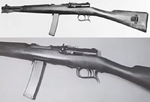The Beretta Model 1918 (Italian: Moschetto Automatico Beretta) was an Italian self-loading carbine that was produced by Beretta.
History[]
In 1917, the Italian Army commissioned several arms manufacturers to develop a single-barreled infantry carbine version of the twin-barreled Villar Perosa submachine gun, which they felt was a useful trench-clearing weapon but impractical in its then-current state. Beretta was one of several companies participating in this commission and placed Tullio Marengoni in charge of the project; the resultant weapon was the M1918. It was trialed by the Army Test Commission against rival designs, including the FIAT and the Ansaldo Crocetti, and the considered the best of the weapons offered. As a result, it was quickly adopted in late 1918 as the Moschetto Automatico Revelli-Beretta. Production ended after the end of World War I. In 1930, Beretta converted many World War I-era M1918s into closed-bolt carbines known as the M1918/30 for the Italian and Argentinian police forces.
The M1918 saw further combat use in when Italy invaded Ethiopia in 1935. In 1938, the M1918 was officially superseded by the Beretta Model 38, but it remained in limited use during World War II. After the war, any M1918s remaining in circulation were retracted from military issue.
Design[]
The M1918 was a delayed blowback carbine; internally it was identical to the Villar Perosa. The only major internal difference was the redesign of the trigger mechanism. Much of the components came from existing Italian military rifles - the furniture was taken from the Vetterli-Vitali and the folding bayonet was taken from the Carcano rifle. Owing to the magazine placement, the gun's sights were offset to the right side. The M1918s were hand-built.
The standard "Monogrillo" model had no selective fire capability and fired exclusively in semi-auto. The "Bigrillo" variant had a two-trigger selective fire capability, as well as redesigned furniture, but lacked the folding bayonet of the earlier version.
Variants[]
Model 1918 Monogrillo[]

The standard Revelli-Beretta carbine with bayonet.

The under-feeding Model 1918 prototype.
The original single-trigger version of the gun, produced from 1918 to about 1920. These were built almost entirely from surplus components taken from the Villar Perosa, the Vetterli-Vitali, and the Carcano carbine. It was taken into service in 1918 and fired in semi-automatic only. It began to be phased out of service during the 1920s, and starting in 1930, Beretta began to repurpose many surplus M1918s into M1918/30 carbines. However, a small number of original M1918s were still in service by the time of World War II.
Beretta also produced a prototype version of the M1918 with a bottom-placed magazine feed. This was achieved by flipping the receiver upside-down; this also meant the cocking slot was facing the left side and the spent cartridges ejected straight upward. This model was not put into full production.
Model 1918 Bigrillo[]

The Model 1918 Bigrillo submachine gun.
This was an improved twin-trigger version of the M1918. This model could provide both automatic fire and single shots. The furniture for the Bigrillo variant was, unlike the standard M1918, built from the ground-up and not recycled from the Vetterli rifle. The folding Carcano bayonet was also omitted in this model. This version was reportedly made at Manifattura Italiana d’Armi, or MIDA.
Model 1918/30[]

The Model 1918/30 carbine.

Model 1918/30 carbine with a different style stock.
Starting in 1930, Beretta re-furbished many surplus M1918s into new weapons known as the M1918/30. This variant used a fixed firing pin and fired from a closed bolt. The cocking was changed from a slot on the right side of the receiver to a retractable ring housed in the rear end of the body. The M1918/30 did not feed from the top; the magazine feed was relocated to the bottom of the receiver. The magazine capacity was 10 or 25 rounds. It was intended as a police weapon and was adopted by the Italian Forestry Corps and Argentine police forces.
Related[]
References[]
- Beretta Model 1918 automatic carbine
- http://www.comandosupremo.com/M1918.html
- https://miles.forumcommunity.net/?t=58626182Italian submachine guns
Pre-WW2 Revelli Mod.1915 "Villar Perosa" · FIAT · Ansaldo · Cei-Rigotti · Beretta Mod.1918 · Savoia · AN · O.V.P. · Armaguerra Mod.35 · Beretta Mod.38WW2-era Sosso · Scotti · Beretta Mod.1 · Beretta Mod.38/42 · FNA-B Model 43 · Beretta Mod.38/44 · Isotta Fraschini · Variara · Armaguerra OG-44 · TZ-45 · Ortolani · GenarPost-WW2 Bernardelli VB · Beretta Mod.38/49 · Lercker machine pistol · Lercker Mod.53 · F.D.A. · Beretta Mod.2 · Beretta Mod.3 · Beretta Mod.5 · Beretta Mod.6 · Beretta Mod.8 · Beretta Mod.12 · FNA-B X4 · Franchi Mod.57 · Spectre M4 · SOCIMI Type 821 · Benelli CB-M2 · Beretta Mx4 Storm